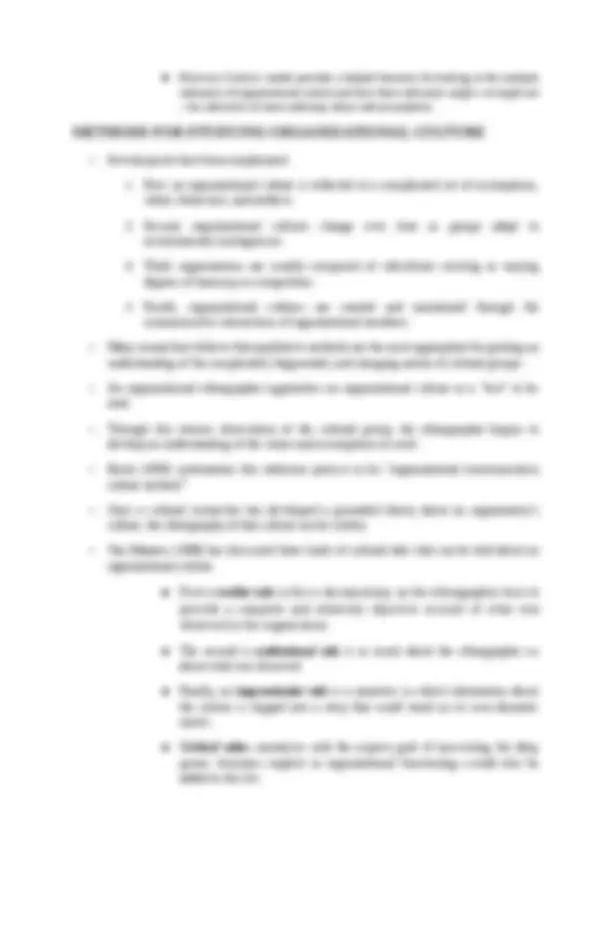



Study with the several resources on Docsity

Earn points by helping other students or get them with a premium plan


Prepare for your exams
Study with the several resources on Docsity

Earn points to download
Earn points by helping other students or get them with a premium plan
Community
Ask the community for help and clear up your study doubts
Discover the best universities in your country according to Docsity users
Free resources
Download our free guides on studying techniques, anxiety management strategies, and thesis advice from Docsity tutors
Edgar schein's model of organizational culture provides a framework to understand the shared basic assumptions, values, behaviors, and artifacts that shape organizational forms and contexts. Schein's definition of culture, the three levels of organizational culture, and methods for studying organizational culture.
What you will learn
Typology: Essays (university)
1 / 3

This page cannot be seen from the preview
Don't miss anything!


[A] pattern of shared basic assumptions that the group learned as it solved its problems of external adaptation and internal integration, that has worked well enough to be considered valid, and, therefore, to be taught to new members as the correct way to perceive, think and feel in relation to those problems.
•.1. First, Schein defines culture as a group phenomenon.
■ (^) Cultural groups can exist on many levels, ranging from civilizations and countries to small organizational or social groups.
■ Schein believes that it is important to highlight the human need for stability, consistency, and meaning and thus the push of many cultural forms toward patterning and integration.
•.2. Second, Schein defines culture as a pattern of basic assumptions, suggesting that the beliefs that make up culture are relatively enduring and difficult to change.
■ Schein acknowledges that organizational culture also encompasses values, behaviors, rules, and physical artifacts.
■ He believes that the core of culture is its basic assumptions and that value and behaviors are better seen as reflections of that culture.
•.3. Third, Schein sees culture as an emergent and developmental process.
■ According to his definition, cultures are learned or invented as a group meets internal and external challenges.
■ The culture of such a company would reflect the contingencies of this environment.
•.4. Finally, Schein’s definition highlights the socializing aspect of organizational culture.
■ When individuals enter an organization, a major part of “learning the ropes” consists of developing an understanding of the assumptions and values that make up that organization’s culture.
•.5. Level 1: Artifacts
■ The most obvious of these are the artifacts or things displayed by organizational members and the overt behavior of organizational members.
■ As Schein (1985) notes, “whereas it is easy to observe artifacts— even subtle ones, such as the way in which status is demonstrated by members — the difficulty is figuring out what the artifacts mean, how they interrelate, what deeper patterns, if any, they reflect”.
•.6. Level 2: Espoused Values
■ The second level of Schein’s model of culture is composed of individual and group values. Values represent preferences or what “ought” to happen.
■ Several interesting points should be raised about this second level of culture.
•.7. (^) Level 3: Basic Assumptions
■ Schein’s third level of culture is the “core” assumptions that individuals in a group hold about the world and how it works.
■ Schein believes that an examination of the basic assumptions might reveal a coherent paradigm that guides a strong and united culture.
■ As Schein (1985) states: “Unless we have searched for the pattern among the different underlying assumptions of a group and have attempted to identify the paradigm by which the members of a group perceive, think about, feel about, and judge situations and relationships, we cannot claim that we have described or understood the group’s culture”.
■ Schein’s definition and model, then, represent culture as a complex pattern of assumptions, values, behaviors, and artifacts.
■ In this case, Schein’s model might be seen as an “onion” with interconnected levels.
■ Schein’s model, of course, oversimplifies the nature of organizational culture and the role of communication in creating and sustaining that culture.